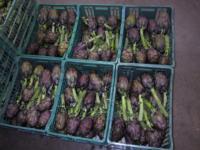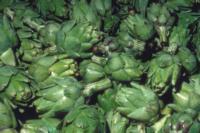Product Description
Indices de Maturité
Le bourgeon comestible, composé d’un cône de bractées, est récolté au stade immature et sélectionné par taille et densité. Les bourgeons surdéveloppés ont une structure ouverte ou étendue; les bractées ont une peau brunâtre; elles sont fermes et filandreuses; les centres d’artichaut ont un aspect duveteux variant du rose au pourpre.
Les indices de qualité sont: bourgeons compacts et bien formés, couleur verte typique, surface de coupe lisse et uniforme, pas de dommages par les insectes ou infligés lors de la manutention et pas de défectuosités. Le poids des bourgeons d’artichaut doit correspondre à leur taille. Les tiges sont généralement coupées de 2,5 à 3,8 cm (1 à 1,5 po) au-dessous de la base de l’artichaut.
Manipulation et stockage post-récolte
0°C (32°F)
Le refroidissement à l’eau glacée, le refroidissement à l’air forcé et le glaçage sont les méthodes communes du refroidissement postrécolte de l’artichaut.
La durée de conservation est généralement moins de 21 jours parce que l’apparence visuelle et la qualité organoleptique se détériorent rapidement.
>95%
| Température | 0°C (32°F) | 5°C (41°F) | 10°C (50°F) | 15°C (59°F) | 20°C (68°F) |
| mL CO2/kg·h | 8-22 | 13-30 | 22-49 | 38-72 | 67-126 |
Pour calculer la production de chaleur, multiplier ml CO2/kg·hr par 440 afin d’obtenir la valeur en BTU/tonne/jour ou par 122 pour l’obtenir en kcal/métrique tonne · jour.
Très faible; <0,1 µl/kg·hr à 20°C (68°F).
Les artichauts ont une faible sensibilité à l’éthylène exogène; cet élément n’est donc pas considéré comme un facteur important pour la manutention et la distribution postrécolte.
L’atmosphère contrôlée ou modifiée a peu d’effet bénéfique sur le maintien de la qualité de l’artichaut. Les conditions de 2 à 3% O2et 3 à 5% CO2 retardent la décoloration des bractées et l’attaque de la pourriture après quelques jours à une température autour de 5°C (41°F). Les atmosphères au-dessous de 2% O2 peuvent causer le noircissement interne des artichauts.
Physiological and Physical Disorders
Blessure due au gel. Ces altérations sont initiées à -1,2°C (29,9°F). Les symptômes d’une affection se caractérisent par la formation d’ampoules sur la cuticule et le brunissement des bractées externes. Le gel peut survenir au champ pour les artichauts récoltés en hiver, cette affectation est utilisée lors de la mise en marché comme un critère de qualité. Les gelures sévères se traduisent par des bractées détrempées, un cœur d’artichaut brun ou noir et le développement d’une apparence gélatineuse après un certain temps.
Blessures par contusion et compression. Elles sont très fréquentes lorsque les pratiques de récolte et de manutention ne sont pas adéquates.
Désordres
La Pourriture Grise (Botrytis cinerea) et la Pourriture Molle Bactérienne (Erwinia carotovora) peuvent être un problème de conservation et de distribution si la température optimale n’est pas respectée. La moisissure opportuniste (Fusarium spp.) peut se développer sur la surface de coupe ou sur les bractées lors d’un entreposage prolongé à basses températures.
References
Des références provenant de sources scientifiquement validées seront ajoutées ultérieurement.





